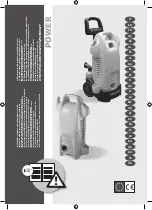
9 Sp
Operación (Continuación)
5. Después de cada uso, limpie todas las superfi-
cies de la lavadora a presión con un paño
limpio y húmedo.
• No guarde la lavadora a presión al aire libre.
• No guarde la lavadora a presión donde podría
congelarse.
CONSEJOS PARA AMPLIAR LA
DURACIÓN DE SU LAVADORA A
PRESIÓN
1. Nunca opere la unidad sin agua.
2. Su lavadora a presión no está hecha para
bombear agua caliente. Nunca conecte su
lavadora a presión a un suministro de agua
caliente, ya que reducirá significativamente la
duración de la bomba.
3.El uso de detergentes que no sean de marca
Campbell Hausfeld puede causar daños a las
partes de la bomba (aros tóricos, sellos, etc.).
Esto vale también para químicos como blan-
queadores, jabón de platos, etc.
4. El funcionamiento de la unidad por más de 1
minuto sin rociar agua hace que el calor se
acumule en la bomba. Esto maltrata muchos
de los componentes de la bomba, debiendo
evitarse esta práctica.
5. Suelte el gatillo antes de cambiar la presión de
la lanza de baja a alta o viceversa. El no hacer-
lo puede reducir la duración de los anillos en
'O' de la lanza.
6. Almacenamiento
5
Pre-Operation (Continued)
www.chpower.com
of surface damage. Large surface areas can be
cleaned more quickly using a wide fan pattern.
ADJUSTABLE PRESSURE NOZZLE
(NOT INCLUDED WITH ALL MODELS)
The adjustable pressure nozzle allows you to
vary the pressure of your spray by turning the
blue end of the nozzle. Turning the blue end
fully clockwise will reduce the pressure to its
minimum. If the pressure washer has a deter-
gent tank system you must use this minimum
pressure setting in order to suction detergent.
Turning the blue end fully counter-clockwise
will increase the pressure to its maximum for
greatest cleaning efficiency. Turning the blue
end changes the pressure but not the fan pat-
tern.
NOZZLE CLEANING INSTRUCTIONS
A clogged or partially clogged nozzle can
cause a significant reduction of water coming
out of the nozzle and cause the unit to pulsate
while spraying.
To clean out the nozzle:
• Turn off and unplug unit.
• Turn off water supply. Relieve any pressure
trapped in the hose by squeezing trigger 2-3
times.
• Separate lance from gun.
• Rotate nozzle to the narrow stream setting.
This opens up the fan blades.
• Using included tip cleaner, or an un-folded
paper clip, insert wire into the nozzle hole
and move back and forth until debris is dis-
lodged. (See Figure 7.)
• Remove additional debris by back-flushing
water through the nozzle. To do this, place
end of a garden hose (with water running) to
end of nozzle for
30 – 60 seconds.
ANGLE TO THE CLEANING SURFACE
When spraying water against a surface, maxi-
mum impact is generated when the water
strikes the surface “head on." However, this
type of impact tends to cause dirt particles to
imbed in the surface, thereby preventing the
desired cleaning action.
The optimum angle for spraying water against
a cleaning surface is 45 degrees.
Figure 5 – Low Pressure Spray
Figure 6 – High Pressure Spray
Figure 7 – Insert tip cleaner in nozzle hole
and move back and forth until debris is dis-
lodged.
Nozzle
Tip Cleaner
Figure 8 – Optimum Angle to Cleaning
Surface




































